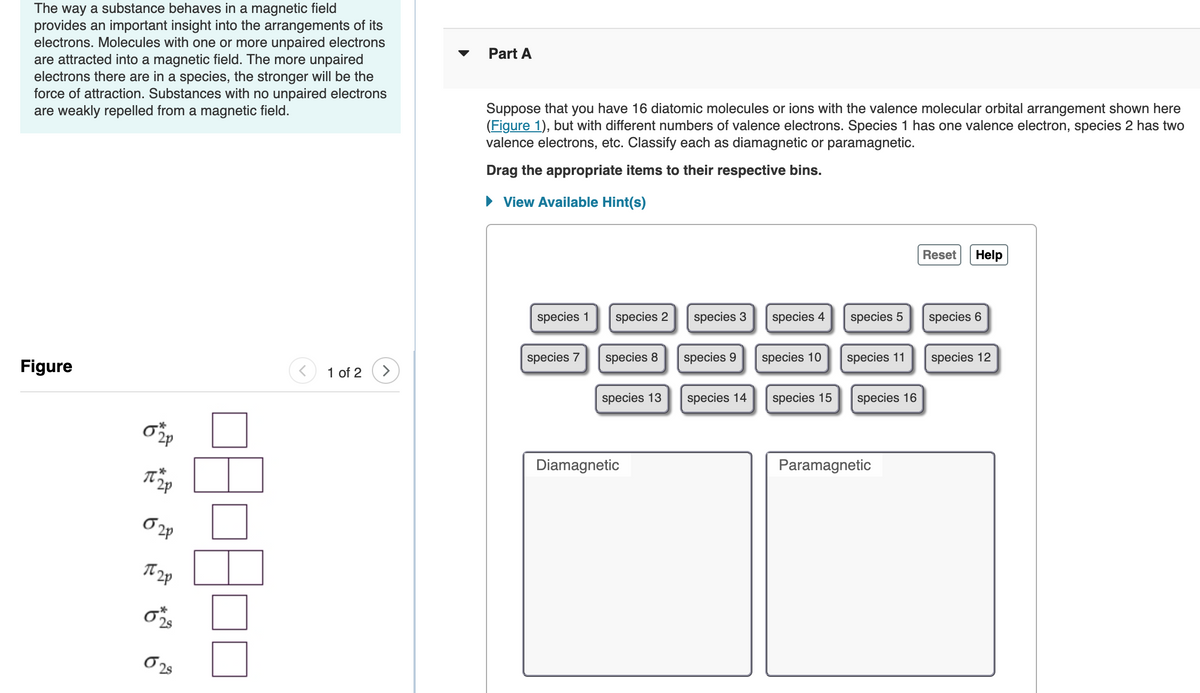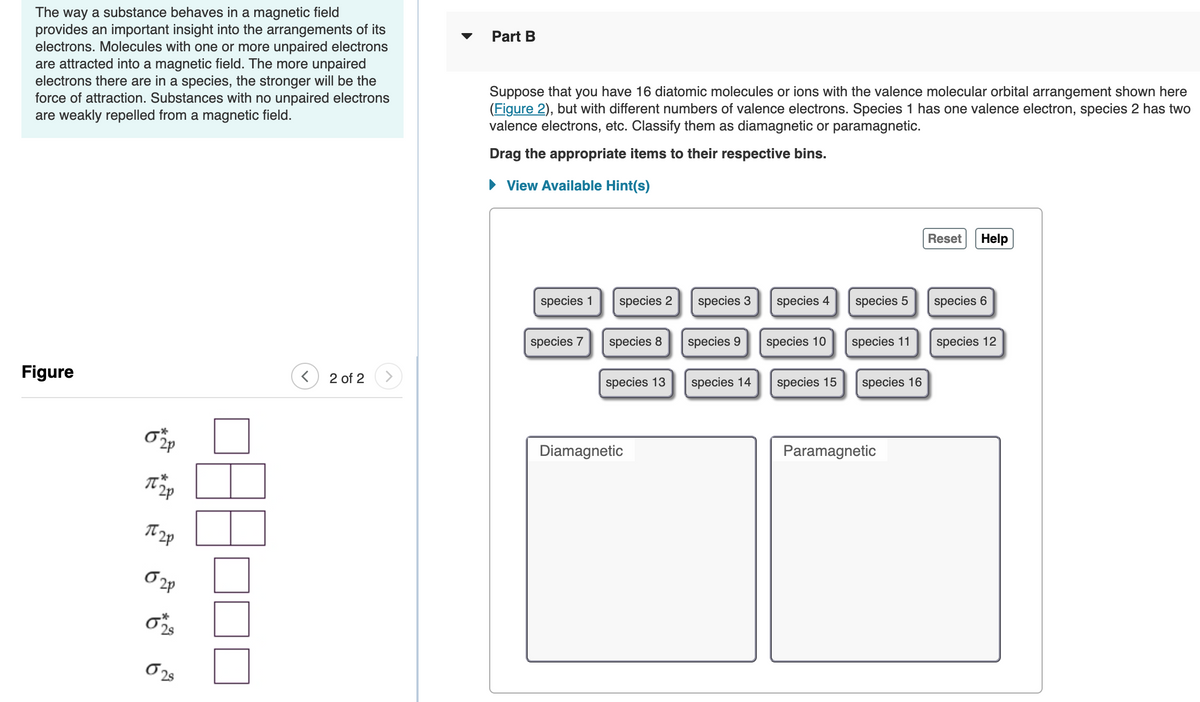he way a substance behaves in a magnetic field rovides an important insight into the arrangements of its lectrons. Molecules with one or more unpaired electrons re attracted into a magnetic field. The more unpaired lectrons there are in a species, the stronger will be the orce of attraction. Substances with no unpaired electrons re weakly repelled from a magnetic field. Part A Suppose that you have 16 diatomic molecules or ions with the valence molecular orbital arrangement shown here (Figure 1), but with different numbers of valence electrons. Species 1 has one valence electron, species 2 has two valence electrons, etc. Classify each as diamagnetic or paramagnetic. Drag the appropriate items to their respective bins. • View Available Hint(s) Reset Help species 1 species 2 species 3 species 4 species 5 species 6 species 7 species 8 species 9 species 10 species 11 species 12 jure 1 of 2 > species 13 species 14 species 15 species 16 Diamagnetic Paramagnetic
he way a substance behaves in a magnetic field rovides an important insight into the arrangements of its lectrons. Molecules with one or more unpaired electrons re attracted into a magnetic field. The more unpaired lectrons there are in a species, the stronger will be the orce of attraction. Substances with no unpaired electrons re weakly repelled from a magnetic field. Part A Suppose that you have 16 diatomic molecules or ions with the valence molecular orbital arrangement shown here (Figure 1), but with different numbers of valence electrons. Species 1 has one valence electron, species 2 has two valence electrons, etc. Classify each as diamagnetic or paramagnetic. Drag the appropriate items to their respective bins. • View Available Hint(s) Reset Help species 1 species 2 species 3 species 4 species 5 species 6 species 7 species 8 species 9 species 10 species 11 species 12 jure 1 of 2 > species 13 species 14 species 15 species 16 Diamagnetic Paramagnetic
Principles of Modern Chemistry
8th Edition
ISBN:9781305079113
Author:David W. Oxtoby, H. Pat Gillis, Laurie J. Butler
Publisher:David W. Oxtoby, H. Pat Gillis, Laurie J. Butler
Chapter5: Quantum Mechanics And Atomic Structure
Section: Chapter Questions
Problem 6P: Using Table 5.2, write down the mathematical expression for the 2px wave function for an...
Related questions
Question
Please answer question 13 Part A and B

Transcribed Image Text:The way a substance behaves in a magnetic field
provides an important insight into the arrangements of its
electrons. Molecules with one or more unpaired electrons
are attracted into a magnetic field. The more unpaired
electrons there are in a species, the stronger will be the
force of attraction. Substances with no unpaired electrons
are weakly repelled from a magnetic field.
Part A
Suppose that you have 16 diatomic molecules or ions with the valence molecular orbital arrangement shown here
(Figure 1), but with different numbers of valence electrons. Species 1 has one valence electron, species 2 has two
valence electrons, etc. Classify each as diamagnetic or paramagnetic.
Drag the appropriate items to their respective bins.
• View Available Hint(s)
Reset
Help
species 1
species 2
species 3
species 4
species 5
species 6
species 7
species 8
species 9
species 10
species 11
species 12
Figure
1 of 2
species 13
species 14
species 15
species 16
Diamagnetic
Paramagneti
2p
2s

Transcribed Image Text:The way a substance behaves in a magnetic field
provides an important insight into the arrangements of its
electrons. Molecules with one or more unpaired electrons
are attracted into a magnetic field. The more unpaired
electrons there are in a species, the stronger will be the
force of attraction. Substances with no unpaired electrons
are weakly repelled from a magnetic field.
Part B
Suppose that you have 16 diatomic molecules or ions with the valence molecular orbital arrangement shown here
(Figure 2), but with different numbers of valence electrons. Species 1 has one valence electron, species 2 has two
valence electrons, etc. Classify them as diamagnetic or paramagnetic.
Drag the appropriate items to their respective bins.
• View Available Hint(s)
Reset
Help
species 1
species 2
species 3
species 4
species 5
species 6
species 7
species 8
species 9
species 10
species 11
species 12
Figure
<) 2 of 2
species 13
species 14
species 15
species 16
Diamagnetic
Paramagnetic
2p
O
2s
Expert Solution
This question has been solved!
Explore an expertly crafted, step-by-step solution for a thorough understanding of key concepts.
This is a popular solution!
Trending now
This is a popular solution!
Step by step
Solved in 4 steps with 4 images

Recommended textbooks for you

Principles of Modern Chemistry
Chemistry
ISBN:
9781305079113
Author:
David W. Oxtoby, H. Pat Gillis, Laurie J. Butler
Publisher:
Cengage Learning

Physical Chemistry
Chemistry
ISBN:
9781133958437
Author:
Ball, David W. (david Warren), BAER, Tomas
Publisher:
Wadsworth Cengage Learning,

Introductory Chemistry: An Active Learning Approa…
Chemistry
ISBN:
9781305079250
Author:
Mark S. Cracolice, Ed Peters
Publisher:
Cengage Learning

Principles of Modern Chemistry
Chemistry
ISBN:
9781305079113
Author:
David W. Oxtoby, H. Pat Gillis, Laurie J. Butler
Publisher:
Cengage Learning

Physical Chemistry
Chemistry
ISBN:
9781133958437
Author:
Ball, David W. (david Warren), BAER, Tomas
Publisher:
Wadsworth Cengage Learning,

Introductory Chemistry: An Active Learning Approa…
Chemistry
ISBN:
9781305079250
Author:
Mark S. Cracolice, Ed Peters
Publisher:
Cengage Learning

Chemistry: The Molecular Science
Chemistry
ISBN:
9781285199047
Author:
John W. Moore, Conrad L. Stanitski
Publisher:
Cengage Learning

Chemistry & Chemical Reactivity
Chemistry
ISBN:
9781337399074
Author:
John C. Kotz, Paul M. Treichel, John Townsend, David Treichel
Publisher:
Cengage Learning

Chemistry & Chemical Reactivity
Chemistry
ISBN:
9781133949640
Author:
John C. Kotz, Paul M. Treichel, John Townsend, David Treichel
Publisher:
Cengage Learning